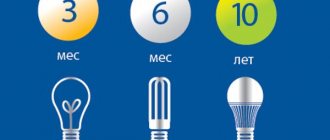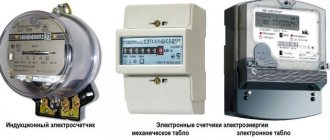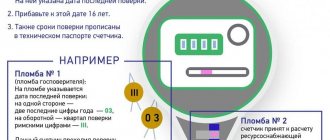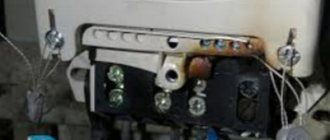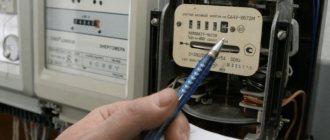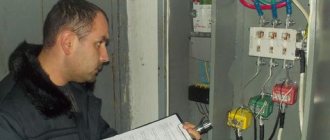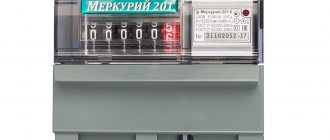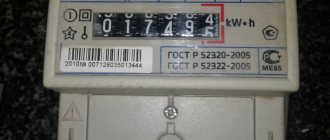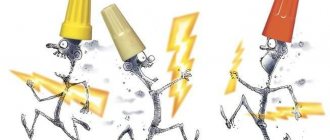MADE IN USSR
This is what the shield (passport) of the SO-I446 10-34 Ampere meter looks like. The rated and maximum currents of the meter are indicated at the bottom of the panel in the center ( 10-34A
). There is clearly no comma, which means that when taking readings, you need to write off all five digits.
Meter SO-I446 5-17 Ampere
And this is the shield (passport) of the SO-I446 5-17 Ampere meter. The rated and maximum currents of the meter are indicated at the bottom of the panel in the center ( 5-17A
). The comma is visible to the naked eye, which means you need to write off four digits.
In the 80s in the Soviet Union, the Vilnius Electrical Equipment Plant - VZET
SO-I446 electricity meters were mass-produced. Not everyone knows that two modifications of SO-I446 electricity meters were produced at the same time. Due to the similar design of the shields (passports) of both modifications, sometimes confusion occurs in taking readings from SO-I446 meters. How electricity consumption is taken into account, with or without a comma, is indicated in paragraph 2.2 of the meter’s passport.
MINISTRY OF INSTRUMENT ENGINEERING FOR AUTOMATION AND CONTROL SYSTEMS VILNIUS ELECTRICAL EQUIPMENT PLANT
SPECIFICATIONS
2.1 Meter type SO-I446 complies with GOST 6570-75 and TU 25-04-2054-76.
2.2 Energy consumption is taken into account in kilowatt hours using 5 digits of the counting mechanism.
If the last digit on the right of the meter is not separated by a comma, then its reading is in whole kilowatt-hours (for 220V, 10-34A);
and if there is a comma before the last digit, then it gives tenths of a kilowatt-hour and is not taken into account when writing off (for 220V, 5-17A).
2.3. The revolution counter on the counting mechanism is used to check the electricity meter at the factory.
. The value of the revolution counter scale division is not a multiple of the number of revolutions of the disk.
2.4. The rated current of the meter is 5 or 10A, the rated voltage is 127 or 220V, (the specific scale is indicated on the panel), the rated frequency is 50Hz.
Good day, dear readers! Today a rather old electric meter came to our table - SO-I446. This electricity meter began to be produced in 1988, although this was many years ago and you can’t find anything like it on sale anymore, it still works great in many houses, cottages and apartments.
The SO-I446 meter is an induction single-phase single-tariff meter that records electricity on an accrual basis. This meter was installed mainly in the household, household segment. The body is made of thick plastic, although it is fragile. On the front panel there is a drum counting mechanism in the form of two blocks: one counts kilowatts and the other in the form of a clock counts fractions of kilowatts/hour. An induction rotating ring is also located under the scoreboard.
Model range of meters
Today it is no longer possible to find similar old-style counters. They have long been forced out of the market by electric models. The main models of meters were SO I446, SO 505 and SO-EE6706. They began to be produced in 1985. Such products had a service life of more than 30 years. Since 2022, everyone has been forcibly asked to exchange old-style models for new, more accurate ones. Therefore, USSR meters can hardly be bought anywhere.
What does the device look like?
Model CO 505 can calculate active electrical energy in a circuit with alternating current. It began to be produced about 40 years ago, and people instantly fell in love with it due to its efficiency.
CO 505 electric meter
Often used in country houses. Can function in high humidity and sudden temperature changes. The case is quite durable that even if dropped it does not crack.
Model SO-EE6706. It also has an electromagnetic operating principle. It is used both in residential buildings and industrial premises. Resistant to mechanical damage, sudden changes in temperature, and also works at −5 degrees Celsius. Considered one of the most popular and beloved among people in the late 1990s.
Specifications
- The ambient temperature in which the meter should be operated must be in the range from +1 to +40 degrees, i.e. the meter is designed for use indoors in which the temperature in winter is not lower than +1 degree.
- Rated voltage 127 or 220 Volts
- Rated current 5 or 10 A
- Frequency 50 Hz
Accuracy class
The accuracy class of the Soviet meter SO-I446 corresponds to class 2.5 on the instrument accuracy scale. Modern meters are more accurate, they correspond to accuracy class 1 or 0.5. When used at home with low electricity consumption, there will not be a big difference in the calculations. Since the accuracy class exceeds 2, most likely the management company will require you to replace it, otherwise the calculation will be carried out according to the standard.
Operation and modification manual
Basic instructions for using the meter are included with it. Different models have their own conditions.
Model SO EE6706 with manual
Not many people know that in the 90s, two modifications of SO-I446 electricity meters were simultaneously produced. Due to the identical design of the shields (passports) of the two modifications, there was sometimes confusion in obtaining readings from SO-I446 devices. Below we describe how to take readings from the CO I446 electric meter.
Electric energy meter
Electric energy meter
(
electric meter
) - a device for measuring the consumption of alternating or direct current electricity (usually in kWh or Ah).
Content
- 1. History
- 2 Operating principle
- 3 Types and types
- 4 Protection against unauthorized access
- 5 See also
- 6 Notes
- 7 Literature
- 8 Links
History [edit | edit code]
The history of the creation of meters is connected with the inventions of electrical devices of the 19th century. A variety of researchers independently and continuously studied electromagnetism, making their own contribution to the creation and subsequent development of electricity meters. These are just a few stages of a long development journey. There was a surge in theoretical discoveries in the field of phenomena establishing a connection between the magnetic and electrical properties of matter already in the 1st half of the 19th century.
In the second half of the 19th century, practitioners joined the authors of theoretical works. Over a short period of time, a hydraulic turbine, a meter, a current transformer, an electric motor, a dynamo, and an electric lamp were invented. As the discoverers believed, time itself gave enlightenment, allowing similar discoveries to be made in opposite ends of the world almost at the same time. For example, the creator of the induction electric meter, Otto Titus Blati, a Hungarian by birth, who was also a co-inventor of the transformer, was sure of this. Anjos Jedlik and Werner von Siemens, each in his own time, invented the dynamo. Which, in turn, made it possible to turn electricity into a commercial product of mass demand. The development of lighting systems required the use of measurement devices and standardization of electricity metering. The first accurate watt-hour meter was patented by Hermann Aron in 1833.
The development of electric power transmission systems towards the creation of high voltage systems was hampered by the main disadvantage of direct current circuits - the inability to convert one voltage level to another. And the long-standing dispute between supporters of DC and AC distribution networks was finally resolved in favor of the latter; this was also facilitated by the invention of the transformer (1885). Attempts to solve the problem of accounting for alternating current electrical energy have led to a number of discoveries. The creation of induction electricity meters was preceded by the discovery of the effect of a rotating magnetic field (Nikola Tesla - 1883, Galileo Ferraris [1] - 1885, Oliver Shellenberger - 1888). The first AC electricity meter was developed by Oliver B. Shellenberger in 1888. Already in 1889, the “Electric meter for alternating currents” was patented by the Hungarian Otto Titutz Blati (for). And in 1894, Shellenberger, commissioned by Westinghouse, created an induction watt-hour meter. The AC active energy watt-hour meter type “A” appeared in 1899, created by Ludwig Gutmann. Continuous improvements to induction electricity meters were launched. Due to their excellent reliability and low cost, meters, originating from the Blati meter and Ferraris induction meters, are still being mass produced, and it is with their help that most electricity measurements are made.
Programming multi-tariff meters
In order for your electronic meter to count energy costs separately at night and during the day, it must be configured correctly.
Conventionally, there are three main tariff zones:
- T1. This tariff zone calculates electricity in the same way as an induction meter, that is, it does not divide into day and night consumption.
- T2. Calculates electricity consumption in two time zones, from 23 to 7 am at a reduced rate, at all other times at a regular rate.
- T3. The most advanced option is a three-period meter, which allows you to divide the day into a regular payment zone, as well as into two special preferential zones for all kinds of organizations and industrial enterprises, the conditions of which depend on the type of their activity.
There are different types of electronic multi-tariff meters, however, almost all of them are the same in terms of reading. Therefore, the method presented below is suitable for most models of electronic energy consumption metering devices.
We calculate the first tariff (T1)
First of all, go to the device menu, after which, using the manual described in the technical instructions for the device, select T1 mode. Most often, you can go to it by pressing the Enter button one by one. If you did everything correctly, then the display should show: control mark, T1 record, value of energy spent.
We calculate the second tariff (T2)
We do everything as indicated above, only now using the Enter button we switch to T2 mode. After which the following is displayed on the display: control mark, T2 record, value of energy spent.
Having the data, it is possible to calculate the cost of energy consumed. How to do this is best shown with a specific example. Suppose we want to know the cost of electrical energy we spent in March. Let's find out the values of the T1 and T2 tariffs for February 25.
For example, we got the following values:
T1 – 1109.5
T2 – 627.2
Amount – 1736.7
And the data we received on March 25 in the same way has the following meaning:
T1 – 1205.3
T2 – 718.8
Amount – 1924.1
Next, we should subtract for each tariff from the values on March 25 the values on February 25, we get:
1205,3 – 1109,5 = 95,8
718,8 – 627,2 = 91,6
Total consumption: 1924.1 – 1736.7 = 187.4
This is how we can get the value of energy consumed per month using a multi-tariff electronic meter. And only then, knowing your tariff, you can calculate the cost of consumed electrical energy; to do this, you need to multiply the resulting amount of consumed electricity by the tariff.
There are different types of electronic multi-tariff meters, however, almost all of them are the same in terms of taking readings
How to take readings
It should not be difficult for you to take readings from the SO-I446 meter; the value or digit capacity of the meter, depending on the type of meter, can be 6 or 5 digits.
Regardless of how many characters, 5 digits are rewritten.
- when taking readings, if there are 6 digits and the last one is separated by a comma or highlighted in a different color, then we rewrite the 5 digits from left to right, we do not take the rightmost one, it shows fractions of kilowatts.
- If the meter has only 5 digits and there is a clock-shaped display at the top right, then we rewrite all 5 digits, the dial on top shows fractions of kilowatts as the 6th digit in the first type of meter.
If you require more detailed characteristics of the meter and the terms of its operation and verification, then you can look at the meter’s passport. If you have lost the technical passport for it, then below we attach a pdf file that can be downloaded or viewed on the website.
Read
Gas meter SGMN-1 G6 - DN 32mm - left/right
Depending on the year in which the meter was manufactured, the verification interval and service life may vary.
Appendix: Passport soy-i446
If you still have any questions, you have a different year of manufacture of the meter or something else, leave comments, we will discuss it together and sort out any issue.

